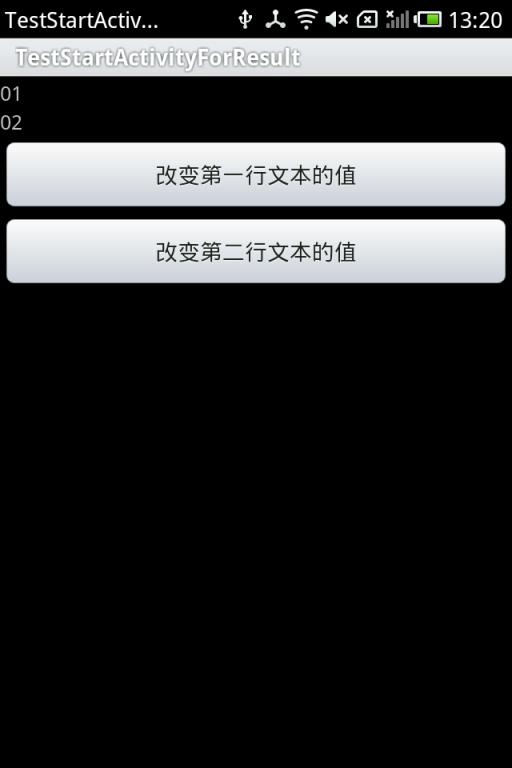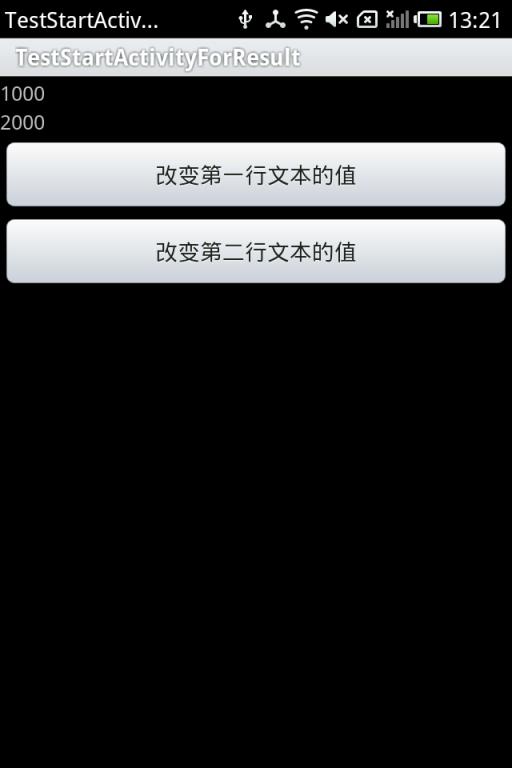Android------startActivityForResult的详细用法
2016-05-10 16:55
661 查看
原文地址:http://blog.csdn.net/sunchaoenter/article/details/6612039
在启动另外一个Activity的时候,有两种方法,一种是直接使用startActivity,另外一种就是使用startActivityForResult。前一种想必大家都明白怎么使用了,我就不废话了。本文主要通过一个Demo来学习一下第二种。
startActivityForResult的主要作用就是它可以回传数据,假设我们有两个页面,首先进入第一个页面,里面有一个按钮,用于进入下一个页面,当进入下一个页面时,进行设置操作,并在其finish()动作或者back动作后,将设置的值回传给第一个页面,从而第一个页面来显示所得到的值。这个有一点像回调方法,就是在第二个页面finish()动作或者back动作后,会回调第一个页面的onActivityResult()方法,所以我们可以重写一下这个方法。直接看代码吧:
第一个页面代码:
[java] view
plain copy
package org.sunchao;
import android.app.Activity;
import android.content.Intent;
import android.os.Bundle;
import android.view.View;
import android.view.View.OnClickListener;
import android.widget.Button;
import android.widget.TextView;
public class TestStartActivityForResultActivity extends Activity implements
OnClickListener {
private TextView mText01;
private TextView mText02;
private Button button01;
private Button button02;
private Intent mIntent;
private int requestCode;
/** Called when the activity is first created. */
@Override
public void onCreate(Bundle savedInstanceState) {
super.onCreate(savedInstanceState);
setContentView(R.layout.main);
mText01 = (TextView) findViewById(R.id.mText01);
mText02 = (TextView) findViewById(R.id.mText02);
button01 = (Button) findViewById(R.id.mButton01);
button02 = (Button) findViewById(R.id.mButton02);
button01.setOnClickListener(this);
button02.setOnClickListener(this);
mText01.setText("01");
mText02.setText("02");
mIntent = new Intent();
mIntent.setClass(TestStartActivityForResultActivity.this,
Activity02.class);
}
@Override
public void onClick(View v) {
switch (v.getId()) {
case R.id.mButton01:
// 请求码的值随便设置,但必须>=0
requestCode = 0;
startActivityForResult(mIntent, requestCode);
break;
case R.id.mButton02:
requestCode = 2;
startActivityForResult(mIntent, requestCode);
break;
default:
break;
}
}
// 回调方法,从第二个页面回来的时候会执行这个方法
@Override
protected void onActivityResult(int requestCode, int resultCode, Intent data) {
String change01 = data.getStringExtra("change01");
String change02 = data.getStringExtra("change02");
// 根据上面发送过去的请求吗来区别
switch (requestCode) {
case 0:
mText01.setText(change01);
break;
case 2:
mText02.setText(change02);
break;
default:
break;
}
}
}
第一个页面布局文件:
[html] view
plain copy
<?xml version="1.0" encoding="utf-8"?>
<LinearLayout xmlns:android="http://schemas.android.com/apk/res/android"
android:orientation="vertical"
android:layout_width="fill_parent"
android:layout_height="fill_parent"
>
<TextView
android:id="@+id/mText01"
android:layout_width="fill_parent"
android:layout_height="wrap_content"
/>
<TextView
android:id="@+id/mText02"
android:layout_width="fill_parent"
android:layout_height="wrap_content"
/>
<Button
android:id="@+id/mButton01"
android:layout_width="fill_parent"
android:layout_height="wrap_content"
android:text="改变第一行文本的值"
/>
<Button
android:id="@+id/mButton02"
android:layout_width="fill_parent"
android:layout_height="wrap_content"
android:text="改变第二行文本的值"
/>
</LinearLayout>
第二个页面代码:
[java] view
plain copy
package org.sunchao;
import android.app.Activity;
import android.content.Intent;
import android.os.Bundle;
public class Activity02 extends Activity {
private int resultCode = 0;
@Override
protected void onCreate(Bundle savedInstanceState) {
super.onCreate(savedInstanceState);
setContentView(R.layout.activity02);
Intent mIntent = new Intent();
mIntent.putExtra("change01", "1000");
mIntent.putExtra("change02", "2000");
// 设置结果,并进行传送
this.setResult(resultCode, mIntent);
// this.finish();
}
}
第二个页面布局文件:
[html] view
plain copy
<?xml version="1.0" encoding="utf-8"?>
<LinearLayout xmlns:android="http://schemas.android.com/apk/res/android"
android:orientation="vertical"
android:layout_width="fill_parent"
android:layout_height="fill_parent"
>
<TextView
android:layout_width="fill_parent"
android:layout_height="wrap_content"
android:text="文本的值已经改变"
/>
</LinearLayout>
AndroidManifest.xml:
[html] view
plain copy
<?xml version="1.0" encoding="utf-8"?>
<manifest xmlns:android="http://schemas.android.com/apk/res/android"
package="org.sunchao"
android:versionCode="1"
android:versionName="1.0">
<uses-sdk android:minSdkVersion="8" />
<application android:icon="@drawable/icon" android:label="@string/app_name">
<activity android:name=".TestStartActivityForResultActivity"
android:label="@string/app_name">
<intent-filter>
<action android:name="android.intent.action.MAIN" />
<category android:name="android.intent.category.LAUNCHER" />
</intent-filter>
</activity>
<activity android:name=".Activity02" />
</application>
</manifest>
运行效果图:



代码下载地址:http://download.csdn.net/source/3448804
在启动另外一个Activity的时候,有两种方法,一种是直接使用startActivity,另外一种就是使用startActivityForResult。前一种想必大家都明白怎么使用了,我就不废话了。本文主要通过一个Demo来学习一下第二种。
startActivityForResult的主要作用就是它可以回传数据,假设我们有两个页面,首先进入第一个页面,里面有一个按钮,用于进入下一个页面,当进入下一个页面时,进行设置操作,并在其finish()动作或者back动作后,将设置的值回传给第一个页面,从而第一个页面来显示所得到的值。这个有一点像回调方法,就是在第二个页面finish()动作或者back动作后,会回调第一个页面的onActivityResult()方法,所以我们可以重写一下这个方法。直接看代码吧:
第一个页面代码:
[java] view
plain copy
package org.sunchao;
import android.app.Activity;
import android.content.Intent;
import android.os.Bundle;
import android.view.View;
import android.view.View.OnClickListener;
import android.widget.Button;
import android.widget.TextView;
public class TestStartActivityForResultActivity extends Activity implements
OnClickListener {
private TextView mText01;
private TextView mText02;
private Button button01;
private Button button02;
private Intent mIntent;
private int requestCode;
/** Called when the activity is first created. */
@Override
public void onCreate(Bundle savedInstanceState) {
super.onCreate(savedInstanceState);
setContentView(R.layout.main);
mText01 = (TextView) findViewById(R.id.mText01);
mText02 = (TextView) findViewById(R.id.mText02);
button01 = (Button) findViewById(R.id.mButton01);
button02 = (Button) findViewById(R.id.mButton02);
button01.setOnClickListener(this);
button02.setOnClickListener(this);
mText01.setText("01");
mText02.setText("02");
mIntent = new Intent();
mIntent.setClass(TestStartActivityForResultActivity.this,
Activity02.class);
}
@Override
public void onClick(View v) {
switch (v.getId()) {
case R.id.mButton01:
// 请求码的值随便设置,但必须>=0
requestCode = 0;
startActivityForResult(mIntent, requestCode);
break;
case R.id.mButton02:
requestCode = 2;
startActivityForResult(mIntent, requestCode);
break;
default:
break;
}
}
// 回调方法,从第二个页面回来的时候会执行这个方法
@Override
protected void onActivityResult(int requestCode, int resultCode, Intent data) {
String change01 = data.getStringExtra("change01");
String change02 = data.getStringExtra("change02");
// 根据上面发送过去的请求吗来区别
switch (requestCode) {
case 0:
mText01.setText(change01);
break;
case 2:
mText02.setText(change02);
break;
default:
break;
}
}
}
第一个页面布局文件:
[html] view
plain copy
<?xml version="1.0" encoding="utf-8"?>
<LinearLayout xmlns:android="http://schemas.android.com/apk/res/android"
android:orientation="vertical"
android:layout_width="fill_parent"
android:layout_height="fill_parent"
>
<TextView
android:id="@+id/mText01"
android:layout_width="fill_parent"
android:layout_height="wrap_content"
/>
<TextView
android:id="@+id/mText02"
android:layout_width="fill_parent"
android:layout_height="wrap_content"
/>
<Button
android:id="@+id/mButton01"
android:layout_width="fill_parent"
android:layout_height="wrap_content"
android:text="改变第一行文本的值"
/>
<Button
android:id="@+id/mButton02"
android:layout_width="fill_parent"
android:layout_height="wrap_content"
android:text="改变第二行文本的值"
/>
</LinearLayout>
第二个页面代码:
[java] view
plain copy
package org.sunchao;
import android.app.Activity;
import android.content.Intent;
import android.os.Bundle;
public class Activity02 extends Activity {
private int resultCode = 0;
@Override
protected void onCreate(Bundle savedInstanceState) {
super.onCreate(savedInstanceState);
setContentView(R.layout.activity02);
Intent mIntent = new Intent();
mIntent.putExtra("change01", "1000");
mIntent.putExtra("change02", "2000");
// 设置结果,并进行传送
this.setResult(resultCode, mIntent);
// this.finish();
}
}
第二个页面布局文件:
[html] view
plain copy
<?xml version="1.0" encoding="utf-8"?>
<LinearLayout xmlns:android="http://schemas.android.com/apk/res/android"
android:orientation="vertical"
android:layout_width="fill_parent"
android:layout_height="fill_parent"
>
<TextView
android:layout_width="fill_parent"
android:layout_height="wrap_content"
android:text="文本的值已经改变"
/>
</LinearLayout>
AndroidManifest.xml:
[html] view
plain copy
<?xml version="1.0" encoding="utf-8"?>
<manifest xmlns:android="http://schemas.android.com/apk/res/android"
package="org.sunchao"
android:versionCode="1"
android:versionName="1.0">
<uses-sdk android:minSdkVersion="8" />
<application android:icon="@drawable/icon" android:label="@string/app_name">
<activity android:name=".TestStartActivityForResultActivity"
android:label="@string/app_name">
<intent-filter>
<action android:name="android.intent.action.MAIN" />
<category android:name="android.intent.category.LAUNCHER" />
</intent-filter>
</activity>
<activity android:name=".Activity02" />
</application>
</manifest>
运行效果图:



代码下载地址:http://download.csdn.net/source/3448804
相关文章推荐
- Android屏幕保护KeyguardManager相关内容学习
- Android Studio 配置ADV发生异常“VT -x is desabled in BIOS”
- Android 网易云课堂第一周笔记16/5/10
- Android为什么要设计出Bundle而不是直接使用HashMap来进行数据传递?
- Android ScrollView如何设置maxHeight
- Android开发工具类之DownloadManagerPro
- Android代码中给获取到的数据添加空格的适配问题
- [置顶] android Git命令家底儿及Git数据通信原理详解
- android Git命令家底儿及Git数据通信原理详解
- android Git命令家底儿及Git数据通信原理详解
- 解决Android原生TextView显示中英文等末尾参差不齐问题
- 控制ListView的自动滚动
- Android 插件化框架 DynamicLoadApk 源码解析
- Android Framework --- PackageManager 分析
- Android如何编译userDebug版本
- Android性能分析工具之TraceView
- Android实现天气查询
- android apk反编译
- 配置使用Android数据库开源框架GreenDao
- nexus maven私服发布Android library
